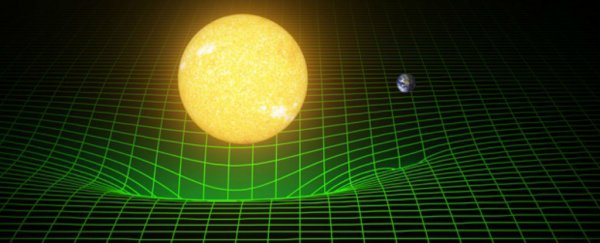Scientists have proposed a new theory that combines some of the most mysterious phenomena in the Universe - black holes, gravitational waves, and axions - to solve one of the most confounding problems in modern physics. And it's got experts in the field very excited.
The theory, which imagines a Universe filled with colossal 'gravitational atoms' that are capable of producing vast clouds of dark matter, predicts that it could be possible to detect entirely new kinds of particles using a giant gravitational wave detector called LIGO.
"This is probably the most promising paper I've seen so far on the new physics we might probe with gravitational waves," MIT particle physicist Benjamin Safdi, who wasn't involved in the research, told Nature.
"It's an awesome idea," adds particle astrophysicist Tracy Slatyer, also from MIT. "The [LIGO] data is going to be there, and it would be amazing if we saw something."
Before we dive headfirst into the crazy physics of this new theory, let's run through the major players.
Black holes are an easy one - vast, matter-annihilating objects that are so remarkably strange, when Albert Einstein's equations first predicted their existence, he didn't believe they could actually be real.
Black holes maintain such powerful gravitational fields, when two of them collide with each other, they produce gravitational waves.
Confirmed for the first time last year, but predicted by Einstein more than a century ago, gravitational waves are ripples in the fabric of space-time that emanate from the most violent and explosive events in the Universe.
And axions? Well, they're a bit more tricky, because unlike black holes and gravitational waves, we're not even sure if axions exist - and we've been searching for them for the past four decades.
Axions are one of the many candidates that have been proposed for dark matter - a mysterious, invisible substance whose gravity appears to hold our galaxies together, and is predicted to make up 85 percent of all matter in the Universe.
Axions are predicted to weigh around 1 quintillion (a billion billion) times less than an electron, and if we can prove their existence, these super-light particles could solve some major theoretical problems with the standard model of physics.
Okay, now that we have all the pieces in place, let's get to this mind-bending new theory. (And yes, we're calling it a theory, not a hypothesis, because it's based on a mathematical framework. More on that here).
A team of physicists led by Asimina Arvanitaki and Masha Baryakhtar from the Perimeter Institute for Theoretical Physics in Canada have proposed that if axions exist and have the right mass, they could be produced in the form of vast clouds of particles by a spinning black hole.
This process would be enough to produce gravitational waves like the ones that were detected last year, and if so, we can use gravitational wave detectors to finally observe the signature of dark matter, and close the gaps in the standard model.
"The basic idea is that we're trying to use black holes… the densest, most compact objects in the Universe, to search for new kinds of particles," Baryakhtar told Ryan F. Mandelbaum at Gizmodo.
You can think of this scenario like this: a black hole is like the nucleus at the centre of a giant, hypothetical gravitational atom. Axions get stuck in orbit around this nucleus, whizzing around like electrons do in regular atoms.
"[E]lectrons interact via electromagnetism, so they let out electromagnetic waves, or light waves. Axions interact via gravity, so they let out gravitational waves," Mandelbaum explains.
If an axion strays too close to the black hole's event horizon, the spin of the black hole will 'supercharge' it, and due to a process called superradiance that has been shown to multiply photons (light particles) in many experiments in the past, this will cause the axions to multiply within a black hole.
These multiplying axions would interact with the black hole in the same way as the original axion near the event horizon, resulting in 1080 axions - "the same number of atoms in the entire Universe, around a single black hole", says Mandelbaum.
"It's so cool, and I haven't read a paper that talked about [superradiance] in years," Chanda Prescod-Weinstein, a University of Washington axion expert who wasn't involved in the research, told him.
"[I]it was really fun to see superradiance and axions in one paper."
These multiplying axions wouldn't just pop into existence randomly - they'd group together in huge quantum waves like the electron clouds you see in an atom.
Within this cloud, any axions that collide with each other would produce gravitons - another hypothetical particle thought to mediate the force of gravitation.
Gravitons are to gravitational waves as photons are to light, and Baryakhtar and her team propose that they would set off continuous waves into the Universe at a frequency set by the axion's mass.
With improved sensitivity, LIGO should be able to spot thousands of these axion signals in a single year, the researchers predict, finally giving them a way to observe the signature of dark matter - something that has eluded scientists for decades.
Of course, grand theories like these always come with some caveats - in order to work, the axions must have a very specific mass, and that mass doesn't necessarily gel well with current predictions on dark matter.
But physicists are still excited by the idea, and with LIGO expected to increase greatly in sensitivity in the next couple of years, it might not be too long before we can test it out for real.
The research has been published in Physical Review D.
